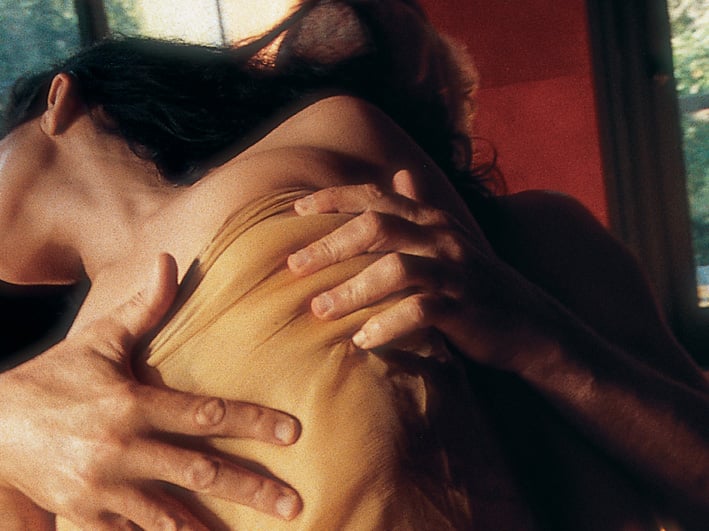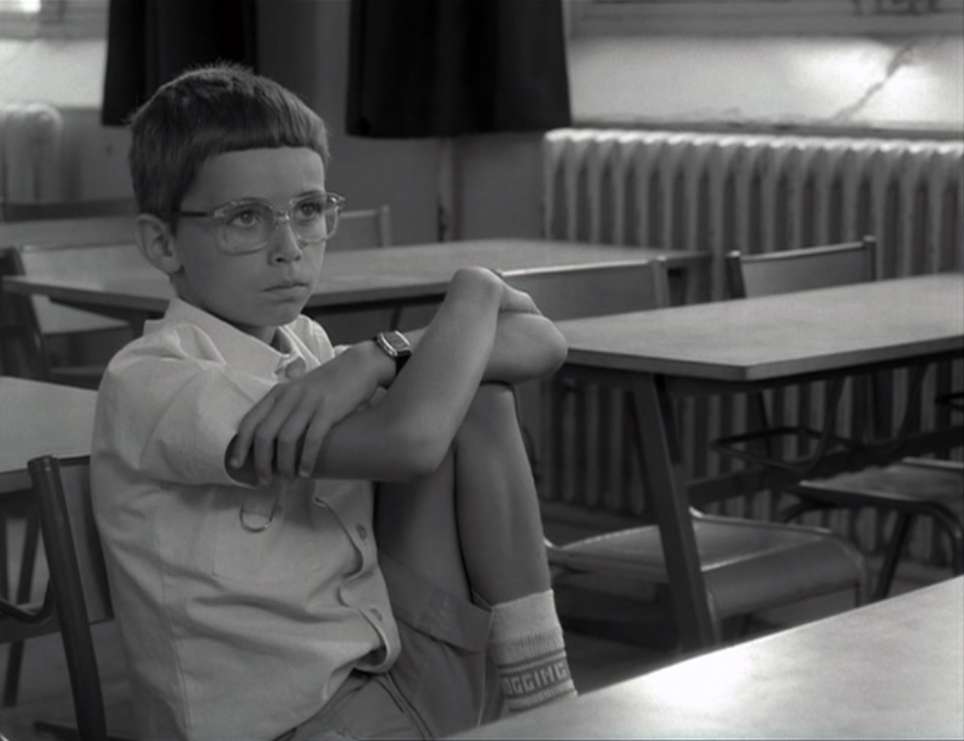
© » KADIST
Mario Garcia Torres
Mario Garcia Torres films a game of Charades among professional actors guessing the former North Korean dictator’s favorite Hollywood films. Indeed rather surprisingly Kim seems to have had a huge collection of Western videos and he published a book called “On the art of the Cinema” in 1973. As the final acknowledgments indicate, Garcia Torres’s work was produced following in depth research, consulting information given by director Shin Sang-ok who has been kidnapped by Kim in 1978, as well as Jerrold Post (The George Washington University) and Timothy Savage (Nautilus Institute for Security and Sustainable Development).

© » KADIST
Mario Garcia Torres
Mario Garcia Torres imagines cinematic devices to replay stories occasionally forgotten by Conceptual art. For him, this is a way of rethinking the tradition in a more personal way, to have a grip on events of recent history and examine them with a curiosity, both critical and sensual. The artist emphasizes the fact that new ideas and meanings may arise from these archaeological narratives.

© » KADIST
Mario Garcia Torres
Mario Garcia Torres discovered the work of artist Oscar Neuestern in an article published in ARTnews in 1969. This article, which is the only trace of his work, is indicative of a lack of interest by Neuestern to leave his name in history; to “defend an artistic activity that has little or no interest to last.” Oscar Neuestern could only remember the previous 24 hours, of which his life and his work are in constant erasure and reconstruction. His practice was “to let things be done with time and the unconscious,” while “not fearing the void.” He looked for the absolute through transparency and symmetry.

© » KADIST
Mario Garcia Torres
In Up All Night, Waiting for the Chelsea Hotel Magic to Spark My Creativity Mario García Torres constructs and documents a hypothetical scene, situating himself within a lineage of artists and creatives that used to congregate at the historic hotel. The long-exposure capture depicts García Torres at multiple stages of brainstorming, devising, and introspection, his ethereal figure connected with artistic giants of the past. Yet, there is also an insipid tone beyond mere insomnia or frustration at the lack of being able to garner inspiration.

© » KADIST
María Buenaventura
The Territory is not for sale is a process of reflection and research with people, thinkers and community leaders from Usme, a rural part of Bogotá on the tenuous verge of becoming urban. As an art object and installation, it comprises multiple stacks of paper each containing the decrees of land expropriation from many different peasant farmers who are being forced to sell their lots of land back to the government. Usme lies at the southern urban-rural border strategically located next to the Páramo de Sumapaz, an enormous neo-tropical tundra ecosystem and water reserve.

© » KADIST
Maria Taniguchi
Untitled (Celestial Motors) is a visual meditation on an icon of modern urban Philippine life—the jeepney. This ubiquitous form of public transportation, originally built from U. S. military jeeps left on the islands after World War II, is normally exuberantly painted and personalized. They are known for their crowded seating and kitsch decorations, which have become an omnipresent symbol of Philippine culture.

© » KADIST
Maria Bussman
Drawing & Print (Drawing & Print)
The drawing “Heidegger’s Cabin” (2005) is inspired by Martin Heidegger’s essay, “The Origin of the Work of Art.” During the artist’s stay in a high alpine area, near a lake reservoir, Bussmann related the landscape in her surroundings to her reading of Heidegger’s terms on the work of art and the meaning of a “thing.” In attempt to link spiritual heights to natural heights, Bussmann metaphorically relates the subjects of being and truth to a hiking path, and its different degrees of challenge and risk. In the drawings rather than finding the optimal path to reach ultimate meaning and materialization, Bussmann never arrives at “Heidegger’s Cabin,” and instead is led off the beaten track to areas she never discovered before. Upon her return from the mountains in 2004 and 2005, she continued to develop the series, leading up to 20 drawings on handmade paper that attempt to problematize Heidegger’s theory on artworks as “things” as bearers of traits, “things” confronting the world of perception, and “things” as formed matter.

© » KADIST
Maria Taniguchi
Maria Taniguchi works across several media but is principally known for her long-running series of quasi-abstract paintings featuring a stylized brick wall device. Full of subtle gradations and low-key modulations, these are her trademark: a sustained, reiterative practice, steeped in repetition but carefully attuned to the economies and the sculptural presence of painting. Her approach to painting is conceptual.

© » KADIST
Maria Fernanda Plata
Unraveling, or “unweaving” sections of fabric, Maria Fernanda Plata arrived at delicate and tenuous-looking forms, both ghostly and gentle. Her careful meditations in fabric reflect Plata’s ongoing interest in the relationship between people and their environments, in fragility, systems, and destruction.
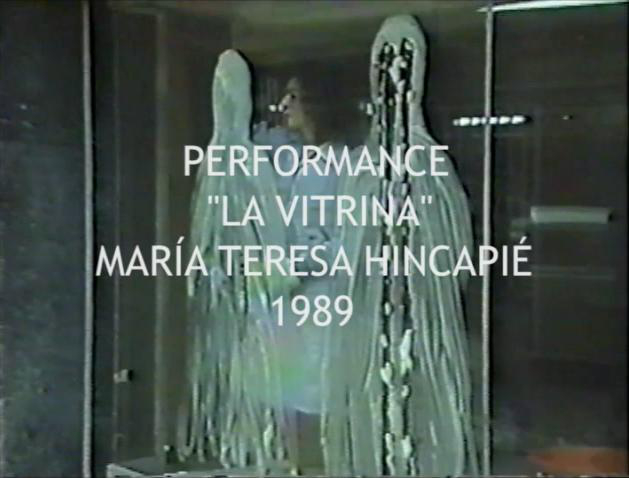
© » KADIST
María Teresa Hincapié
In the performance video Vitrina , María Teresa Hincapié stood inside a storefront window in downtown Bogota, unannounced, for eight hours a day, wearing a uniform and initially carrying out cleaning chores. As the day and passers went by, the routine became more playful: she would send kisses to bus drivers on the busy Avenida Jiménez who would return them, use the newspaper with which she was shining the glass to flirtatiously hide and engage with an improvised audience or draw the shape of her body with soap and a sponge. She would interrupt these chores to carry out other ‘feminine’ activities, like brushing her hair or applying make-up, only to return to frantically cleaning the transparent surface that separated her from the public.
![Elevación [Elevation]](https://kadist.org/wp-content/uploads/2022/09/IMG_escena001_3513-scaled.jpg)
© » KADIST
Ana María Millán
Interested in role-play and videogames, Ana María Millán developed workshops with different communities in order to create characters and scenarios for her animations, often in collaboration with a choreographer. Elevación evokes various narratives inspired by the comicstrip Marquetalia, Raíces de la Resistencia (Marquetalia, Roots of the Resistance) (2011). This comic strip is a memoir of the FARC (Revolutionary Armed Forces of Colombia) guerillas written by Jesús Santrich, one of its leaders who, after the 2016 Peace Agreement, rejoined dissident members of the organization in a clandestine guerrilla splinter group in 2019.

© » KADIST
María Isabel Rueda
The Real. Retrato de Norman Mejía. (The Real. A Portrait of Norman Mejía.)

© » KADIST
João Maria Gusmão and Pedro Paiva
The artist duo João Maria Gusmão and Pedro Paiva traveled to Japan for a month to make a series of short 16mm films, often shot in slow-motion. This film, shown in continuous loop, has a run-time of just under 3 minutes, and is presented without sound. It captures a traditional Shisa (combination of a dog and lion from Okinawan mythology) animated by an invisible person.
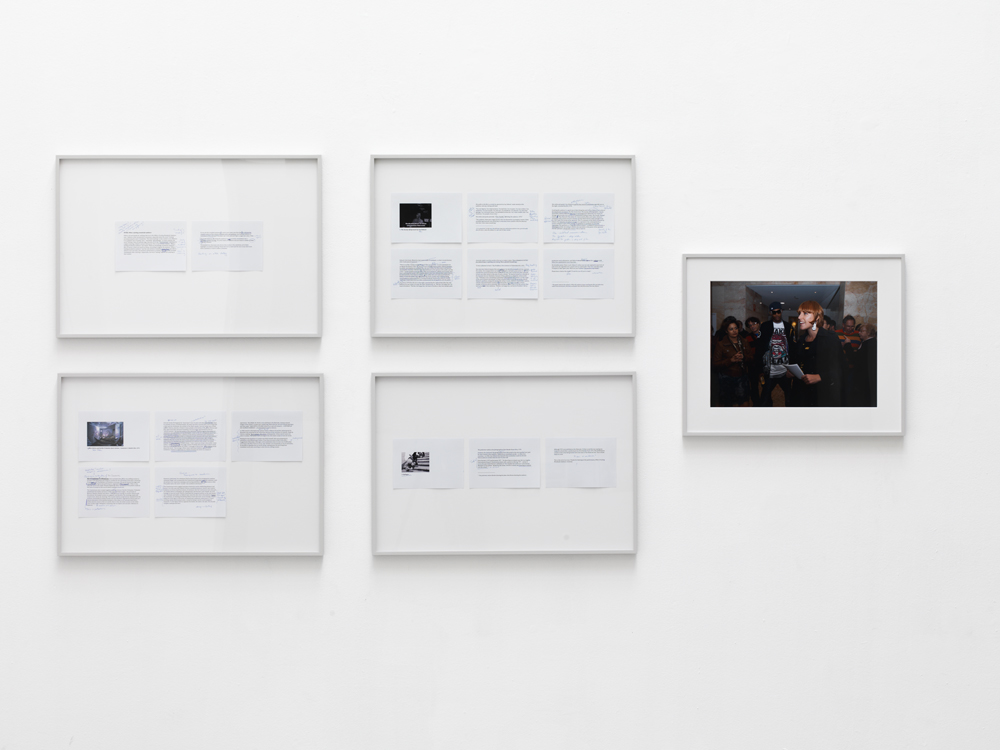
© » KADIST
Dora Garcia
Drawing & Print (Drawing & Print)
Dora Garcia’s work is a result of institutional critique and more generally that of language, following the conceptual artists of the 1960s like Weiner and Kosuth and Fraser from the 1980s and 1990s. What a fucking wonderful audience (2008) is positioned conveniently at the crossroads of several trends identified in the work of the artist. The performance from which it is derived, was made at the Biennale of Sydney in 2008, taking the form of a guided tour at the Museum of Modern Art in Sydney and focuses on artworks that were not physically present.

© » KADIST
Rodrigo Torres
Drawing & Print (Drawing & Print)
In his Conceito abstrato series, however, Rodrigo Torres turns to the abstract, using the shapes, numbers, lines, and subtle colors of international currencies to create non-representational forms with lavish geometries and baroque curving forms.

© » KADIST
Dora Garcia
KLAU MICH is a TV and performance project by Dora García with Ellen Blumenstein, Samir Kandil, Jan Mech, TheaterChaosium, and Offener Kanal Kassel, during the 100 days of dOCUMENTA (13).

© » KADIST
Marie Voignier
Tourisme International was shot as the recording of a show on the scale of a country. In the urgency of perpetual travel, this tourist journey visits monuments, museums, institutions presented by North Korean guides whose voices we do not hear. Marie Voignier entirely redesigned the sound of each sequence in post-synchronization, making only the living experiences of footsteps and rustling of clothes audible, to create a new universe, disconnected from the official discourses.

© » KADIST
Luis Garciga
In Destinos Posibles Garciga performs a service in Havana, Cuba by offering strangers in the streets a “ride” to wherever they are going for free, in exchange he demands that the passengers address the question “what do they want from life?” A poignant video within the context of the limitations the Cubans have in terms of choices, desires, fantasies, and longing.

© » KADIST
Félix González-Torres
Behind the simplicity and beauty of this untitled photograph of a brilliantly-colored flowerbed by Félix González-Torres are two remarkable stories of love, loss, and resilience. As with most of his works, the photograph is untitled followed by a parenthesis that provides some context clues. In this case, an inscription on the reverse of the photograph reads: For Laura (Alice B. Toklas + Gertrude Stein Flower Bed in Paris).

© » KADIST
Fabiola Torres-Alzaga
Drawing & Print (Drawing & Print)
Fabiola Torres-Alzaga plays with magic, illusion, and sleight-of-hand, fabricating installations, drawings, and films that toy with our perceptions. Her interests and the resulting aesthetic projects seem couched in the 19thcentury sideshow, more than the contemporary art world. In her delicate drawings, Adaptando la Carta, layers of tracing paper reveal different hand positions, concealing and revealing a playing card hidden among the curves of the magician’s hand.
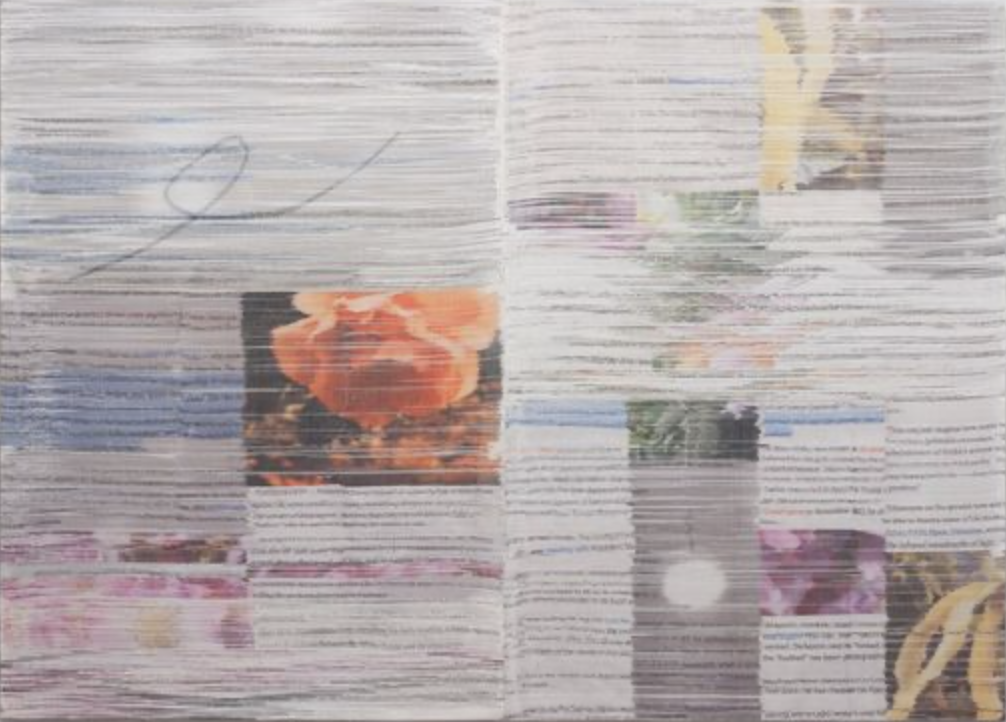
© » KADIST
Margo Wolowiec
Imagine How Many by Margo Wolowiec is a woven polyester depiction of blurred text and floral images found on social media, distorted beyond complete recognition. It resembles a newspaper with a conspicuous “fold” down the middle, but its contents are undoubtedly drawn from Wolowiec’s practice of image aggregation and do not follow the clear formatting newspapers normally possess. Instead, Wolowiec has created an alternative publication of sorts, drawing in a third, comparative source of “networked” imagery and information, inserting the concept of publication and social media into her greater examination of the structures governing dissemination.

© » KADIST
Marco Rios
This is a poignant and humorous self portrait that turns the camera on the artist’s own physical inability to cry. With non-stop cascades of “tears” coming down from his eyes, the impact of the work is in the contrast between the still image of the artist and the constant movement of the waterfalls flowing down. An image of impotency, it is also a beautiful “moving picture” in the formal sense.
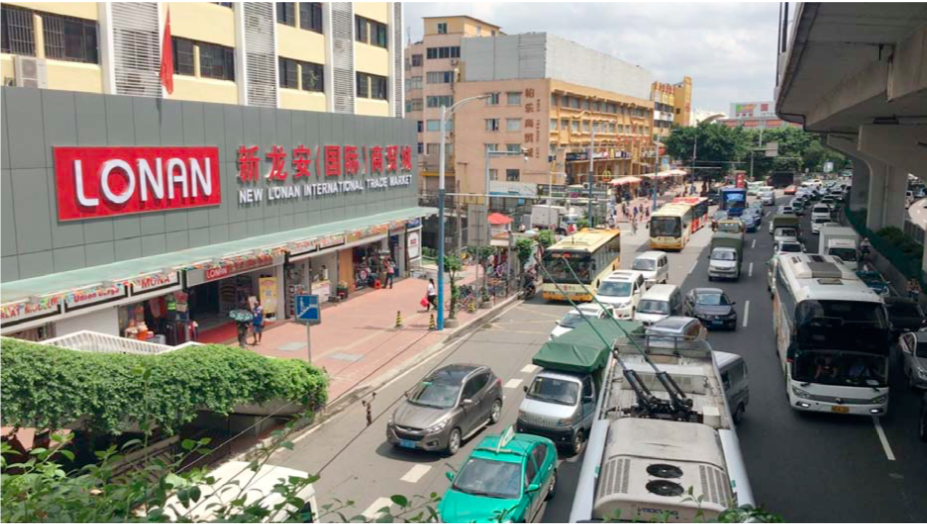
© » KADIST
Marie Voignier
“Na China” means “In China” in Igbo language. Marie Voignier’s film NA CHINA! focuses on the African women communities who have emigrated to Guangzhou, in the southeast of China.

© » KADIST
Margo Wolowiec
Drawing & Print (Drawing & Print)
Wolowiec’s textile work Not This Time (2015) translates pixelated images into sensuous fabric and ink based forms that are at once beautiful in their abstraction and anxiety-ridden in their visualization of a malfunctioning digital world. In order to produce this work, Wolowiec selects a grouping of digital images from web-based sources that have a glitch, an aberration in which a short-lived technical fault results in distortions in an image’s display. Through a dye sublimination ink process, the images are printed onto strands of thread pixel by pixel, which the artist then weaves into a final work.

© » KADIST
Mario Ybarra Jr.
Ammo Bunker (2009) is a multipart installation that includes large-scale wall prints and an architectural model. The work takes as its departure point the history of Wilmington, Ybarra’s native hometown in southern Los Angeles. The piece refers to a Civil War era ammunition store that Ybarra found at the heart of the harbor close to Long Beach.

© » KADIST
Marion Scemama, David Wojnarowicz
Political artist, painter, writer, performer, photographer, David Wojnarowicz, was one of the leading figures of the New York Downtown artistic scene of the 1980s. His use of image, language and collage generated a new method of idea communication. The series of five videos Collaborative Film Collection made in collaboration with Marion Scemama in 1989 is emblematic of his artistic practice, it unfolds through performance, films, photographs, texts and paintings.

© » KADIST
Marion Scemama, David Wojnarowicz
Political artist, painter, writer, performer, photographer, David Wojnarowicz, who died of AIDS in 1992 in New York City, was one of the leading figures of the New York Downtown artistic scene of the 80s. His use of image, language and collage generated a new method of idea communication. The series of five videos Collaborative Film Collection made in collaboration with Marion Scemama in 1989 is emblematic of his artistic practice, it unfolds through performance, films, photographs, texts and paintings.

© » KADIST
Marion Scemama, David Wojnarowicz
Political artist, painter, writer, performer, photographer, David Wojnarowicz, who died of AIDS in 1992 in New York City, was one of the leading figures of the New York Downtown artistic scene of the 80s. His use of image, language and collage generated a new method of idea communication. The series of five videos Collaborative Film Collection made in collaboration with Marion Scemama in 1989 is emblematic of his artistic practice, it unfolds through performance, films, photographs, texts and paintings.

© » KADIST
Marion Scemama, David Wojnarowicz
Political artist, painter, writer, performer, photographer, David Wojnarowicz, who died of AIDS in 1992 in New York City, was one of the leading figures of the New York Downtown artistic scene of the 80s. His use of image, language and collage generated a new method of idea communication. The series of five videos Collaborative Film Collection made in collaboration with Marion Scemama in 1989 is emblematic of his artistic practice, it unfolds through performance, films, photographs, texts and paintings.
Mario Garcia Torres
- location: Mexico City, Mexico
- year born: 1975
- gender: male
- nationality: Mexican
- home town: Monclova, Mexico
Marion Scemama, David Wojnarowicz
Marion Scemama is a French photographer and filmmaker...
Manuel Correa
Manuel Correa’s practice deals with the reconstruction of post-conflict intergenerational memory in contemporary societies...
Maria Taniguchi
Throughout her paintings, sculptures, and videos, Maria Taniguchi unpacks knowledge and experience—connecting material culture, technology, and natural evolution—and investigates space and time, along with social and historical contexts...
Margo Wolowiec
Margo Wolowiec uses her multidisciplinary practice to examine space, material versus conceptual practices, and affective responses...
Daria Martin
A number of Daria Martin’s films explore the relationship between humans and machines and make reference to modernist art, whether through the work of the Bauhuas (Schlemmer), Surrealism (Giacometti’s Palace at 4 AM) or American art of the 1960s and 1970s...
Marie Voignier
Marie Voignier’s work presents a subtle criticism of the transitory status of action within the social and political elds...
Sergio De La Torre
Sergio De La Torre has worked with and documented the manifold ways in which citizens reinvent themselves in the city they inhabit, as well as the site-specific strategies they deploy to move “in and out modernity.” De La Torre often collaborates with his subjects, resulting in both intimate and critical reflections on topics like housing, immigration, and labor...
Dora Garcia
Dora Garcia was born in 1965 in Valladolid, Spain...
Rodrigo Torres
Brazilian artist Rodrigo Torres has been deconstructing international paper currencies to form intricate collages of color, line, shape, and texture for several years...
Valeska Soares
- location: New York, New York
- year born: 1957
- gender: female
- nationality: Brazilian
- home town: Belo Horizonte, Brazil
Mario Ybarra Jr.
- location: Los Angeles, California
- year born: 1973
- gender: male
- nationality: American
- home town: Los Angeles, California
Maria Fernanda Plata
Colombian artist Maria Fernanda Plata found herself drawn to fabric as a material with conceptual implications while on a residency in Vietnam...
Etel Adnan and Lynn Marie Kirby
Visual artist, poet, and essayist Etel Adnan writes what must be communicated through language, and paints what cannot...
Maria Bussman
Maria Bussmann’s works represent an insistent attempt to fathom the epistemological quality of her medium, drawing...
Aria Dean
Through art, text, and exhibition making, Aria Dean analyzes the structure and circulation of images and subjectivities in relation to material, cultural histories, and technology...
Marco Rios
Marco Rios is an artist and curator working mainly in sculpture, performance, photography and video...
Luis Garciga
Luis Garciga’s work and research since 2003 has been a journey attempting to redefine the invariant anthropologies that appear in less “global” contexts and communities...
John Morris
John Morris practices what critic Allan Weiss calls “ poetics of the ad infinitum” an ecstatic but precise doodling in which handmade marks stand for unrepresentable holism...
Fabiola Torres-Alzaga
- year born: 1978
- gender: female
- nationality: Mexican
- home town: Mexico City, Mexico
Gala Porras-Kim
Gala Porras-Kim’s work plays objects against their framing to consider how an artefact’s “message” is tempered by display, use, historic setting, and other modes of exchange...
-
1980-1989
Jean-Marie Straub and Danièle Huillet
1982En rachâchant is based on the short story Ah! Ernesto! (1971) by Marguerite Duras in which the child Ernesto does not want to go to school anymore as all that he is taught are things he does not know...
María Teresa Hincapié
1989In the performance video Vitrina , María Teresa Hincapié stood inside a storefront window in downtown Bogota, unannounced, for eight hours a day, wearing a uniform and initially carrying out cleaning chores...
Marion Scemama, David Wojnarowicz
1989Political artist, painter, writer, performer, photographer, David Wojnarowicz, was one of the leading figures of the New York Downtown artistic scene of the 1980s...
Marion Scemama, David Wojnarowicz
1989Political artist, painter, writer, performer, photographer, David Wojnarowicz, who died of AIDS in 1992 in New York City, was one of the leading figures of the New York Downtown artistic scene of the 80s...
Marion Scemama, David Wojnarowicz
1989Political artist, painter, writer, performer, photographer, David Wojnarowicz, who died of AIDS in 1992 in New York City, was one of the leading figures of the New York Downtown artistic scene of the 80s...
Marion Scemama, David Wojnarowicz
1989Political artist, painter, writer, performer, photographer, David Wojnarowicz, who died of AIDS in 1992 in New York City, was one of the leading figures of the New York Downtown artistic scene of the 80s...
Marion Scemama, David Wojnarowicz
1989Political artist, painter, writer, performer, photographer, David Wojnarowicz, who died of AIDS in 1992 in New York City, was one of the leading figures of the New York Downtown artistic scene of the 80s...
-
1990-1999
Félix González-Torres
1992Behind the simplicity and beauty of this untitled photograph of a brilliantly-colored flowerbed by Félix González-Torres are two remarkable stories of love, loss, and resilience...
-
2000-2009
Mario Garcia Torres
2004Mario Garcia Torres imagines cinematic devices to replay stories occasionally forgotten by Conceptual art...
Daria Martin
2004Soft Materials is a curious, touching but also disturbing sequence of confrontations between two people: a man and a woman, and machines...
Mario Garcia Torres
2005Mario Garcia Torres films a game of Charades among professional actors guessing the former North Korean dictator’s favorite Hollywood films...
Maria Bussman
Drawing & Print
2005(Drawing & Print) The drawing “Heidegger’s Cabin” (2005) is inspired by Martin Heidegger’s essay, “The Origin of the Work of Art.” During the artist’s stay in a high alpine area, near a lake reservoir, Bussmann related the landscape in her surroundings to her reading of Heidegger’s terms on the work of art and the meaning of a “thing.” In attempt to link spiritual heights to natural heights, Bussmann metaphorically relates the subjects of being and truth to a hiking path, and its different degrees of challenge and risk...
Dora Garcia
Drawing & Print
2008(Drawing & Print) Dora Garcia’s work is a result of institutional critique and more generally that of language, following the conceptual artists of the 1960s like Weiner and Kosuth and Fraser from the 1980s and 1990s...
Sergio De La Torre
2008Nuevo Dragon City is a reenactment of a historical event from 1927 in which six Chinese were either trapped or voluntarily hid themselves inside a building in northern Mexico...
Daria Martin
2008In keeping with her mythological proclivity, Minotaur (2009) casts a new light on an old narrative...
Luis Garciga
2009In Destinos Posibles Garciga performs a service in Havana, Cuba by offering strangers in the streets a “ride” to wherever they are going for free, in exchange he demands that the passengers address the question “what do they want from life?” A poignant video within the context of the limitations the Cubans have in terms of choices, desires, fantasies, and longing....
Mario Ybarra Jr.
2009Ammo Bunker (2009) is a multipart installation that includes large-scale wall prints and an architectural model...
-
2010-2019
Mario Garcia Torres
2010In Up All Night, Waiting for the Chelsea Hotel Magic to Spark My Creativity Mario García Torres constructs and documents a hypothetical scene, situating himself within a lineage of artists and creatives that used to congregate at the historic hotel...
Marco Rios
2010This is a poignant and humorous self portrait that turns the camera on the artist’s own physical inability to cry...
María Buenaventura
2011The Territory is not for sale is a process of reflection and research with people, thinkers and community leaders from Usme, a rural part of Bogotá on the tenuous verge of becoming urban...
Sergio De La Torre
2011This is not in Spanish looks at the ways in which the Chinese population in Mexico navigates the daily marginalization they encounter there...
Maria Taniguchi
2012Untitled (Celestial Motors) is a visual meditation on an icon of modern urban Philippine life—the jeepney...
Dora Garcia
2012KLAU MICH is a TV and performance project by Dora García with Ellen Blumenstein, Samir Kandil, Jan Mech, TheaterChaosium, and Offener Kanal Kassel, during the 100 days of dOCUMENTA (13)....
Valeska Soares
2012Relying on repetition and repurposed materials, Soares works to interrogate time—its measurement, its passing, and its meaning...
Fabiola Torres-Alzaga
Drawing & Print
2013(Drawing & Print) Fabiola Torres-Alzaga plays with magic, illusion, and sleight-of-hand, fabricating installations, drawings, and films that toy with our perceptions...
Marie Voignier
2014Tourisme International was shot as the recording of a show on the scale of a country...
Maria Taniguchi
2015Maria Taniguchi works across several media but is principally known for her long-running series of quasi-abstract paintings featuring a stylized brick wall device...
Maria Fernanda Plata
2015Unraveling, or “unweaving” sections of fabric, Maria Fernanda Plata arrived at delicate and tenuous-looking forms, both ghostly and gentle...
João Maria Gusmão and Pedro Paiva
2015The artist duo João Maria Gusmão and Pedro Paiva traveled to Japan for a month to make a series of short 16mm films, often shot in slow-motion...
Margo Wolowiec
Drawing & Print
2015(Drawing & Print) Wolowiec’s textile work Not This Time (2015) translates pixelated images into sensuous fabric and ink based forms that are at once beautiful in their abstraction and anxiety-ridden in their visualization of a malfunctioning digital world...
Rodrigo Torres
Drawing & Print
2016(Drawing & Print) In his Conceito abstrato series, however, Rodrigo Torres turns to the abstract, using the shapes, numbers, lines, and subtle colors of international currencies to create non-representational forms with lavish geometries and baroque curving forms....
Margo Wolowiec
2017Imagine How Many by Margo Wolowiec is a woven polyester depiction of blurred text and floral images found on social media, distorted beyond complete recognition...
Gala Porras-Kim
Drawing & Print
2017(Drawing & Print) The graphite drawing 4 mourners on a mantel by Gala Porras-Kim is part of a larger installation and body of research, entitled An Index and Its Settings (Un Índice y Sus Entornos) , in which the artist reconsiders 235 ancient burial figures (from circa 200 BCE – 50 CE) from what is now Mexico’s Pacific coast that are part of the Proctor Stafford Collection held by the Los Angeles County Museum of Art (LACMA)...
Etel Adnan and Lynn Marie Kirby
Drawing & Print
2017(Drawing & Print) In conjunction with KADIST’s 2017 exhibition If Not Apollo, the Breeze , artist and filmmaker Lynn Marie Kirby performed Transmissions , a video and live reading created with longtime collaborator Etel Adnan...
Manuel Correa
2018La Forma del Presente (The Shape of Now) by Manuel Correa follows a group of survivors of Colombia’s 50-year long armed conflict facing the impossible task of agreeing on a shared past...
Ana María Millán
2019Interested in role-play and videogames, Ana María Millán developed workshops with different communities in order to create characters and scenarios for her animations, often in collaboration with a choreographer...
-
2020-2029
Manuel Correa
2020Manuel Correa’s short film Didn’t Know I Died is a testimonial portrait of the acclaimed Colombian poet Olga Elena Mattei...
Manuel Correa
2020Manuel Correa’s documentary Four Hundred Unquiet Graves is a powerful and vulnerable visual essay about the descendants of those who were disappeared during the Spanish Civil War from 1936–1939...


